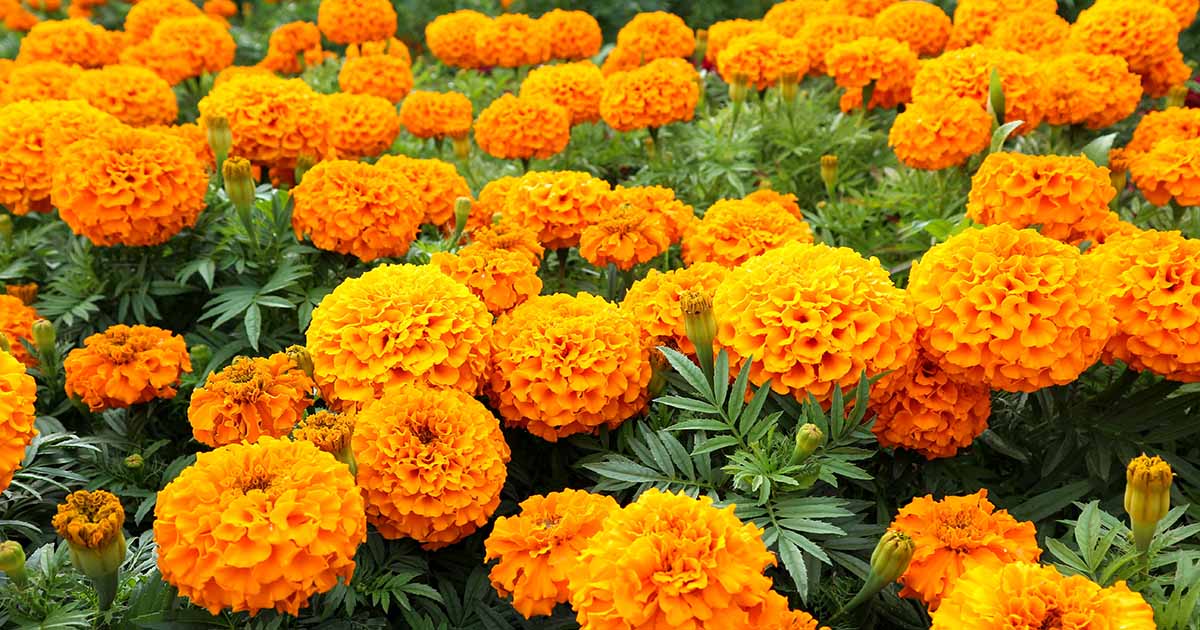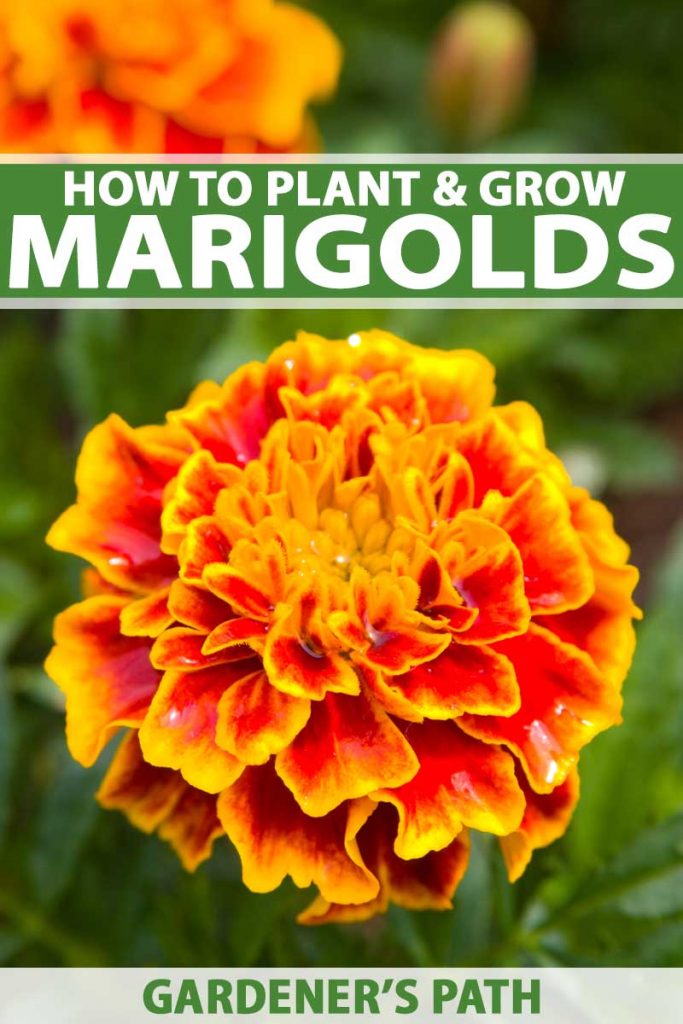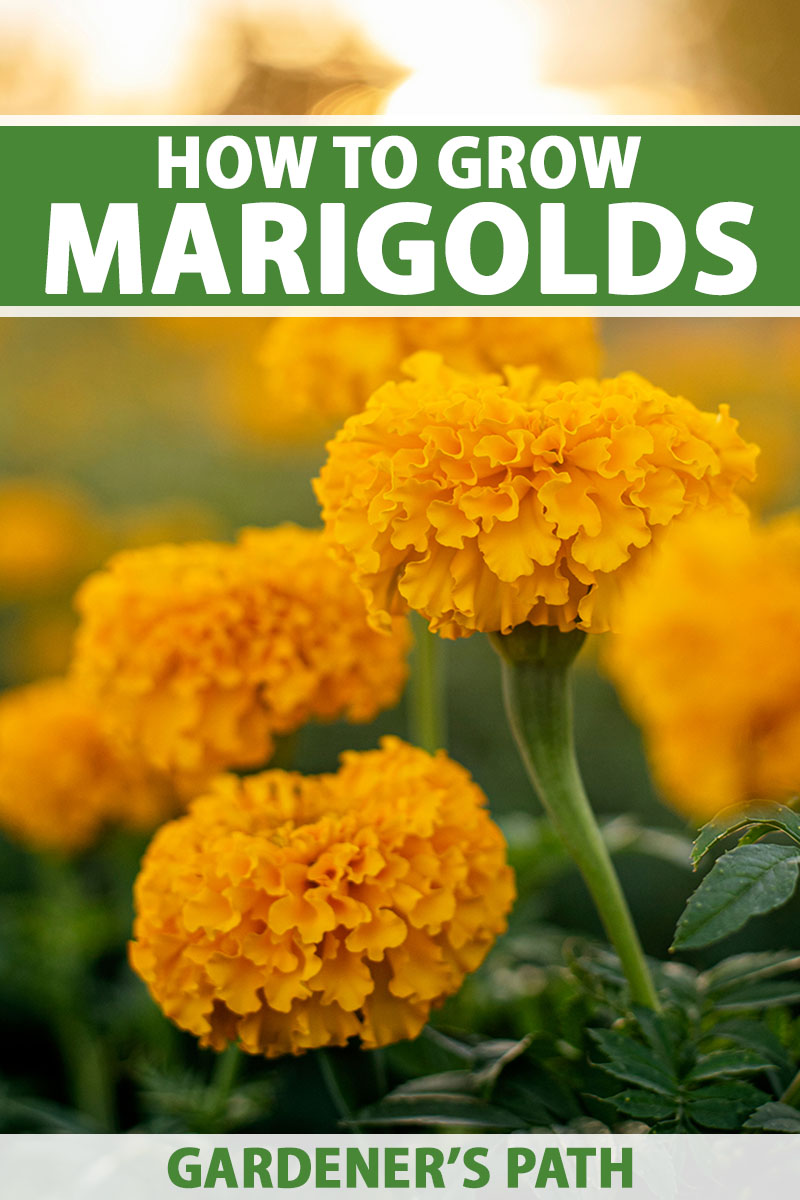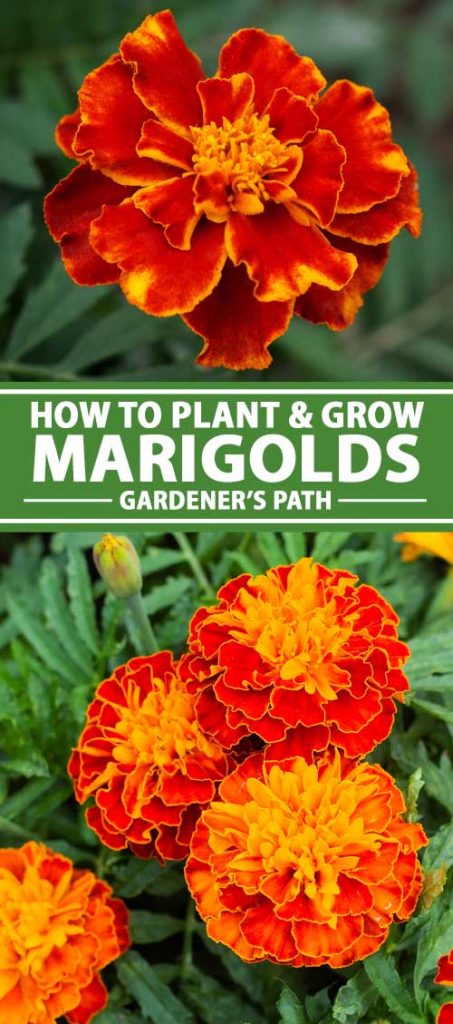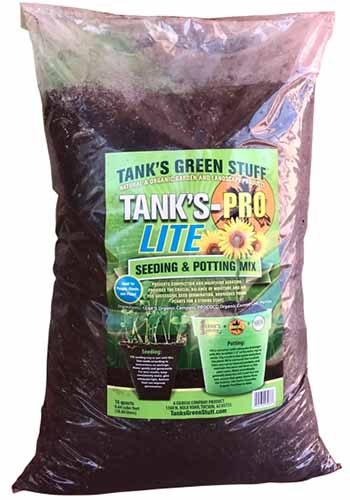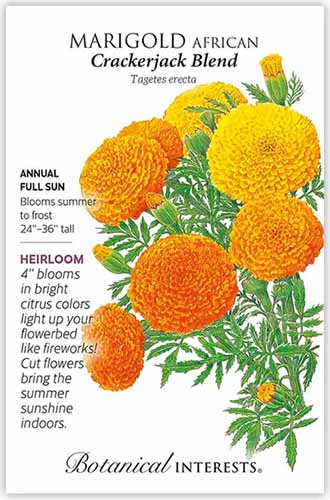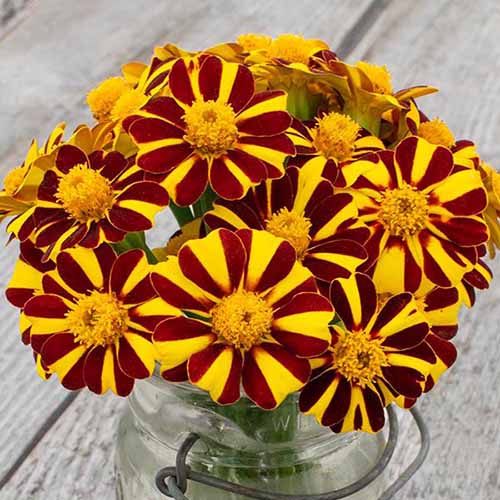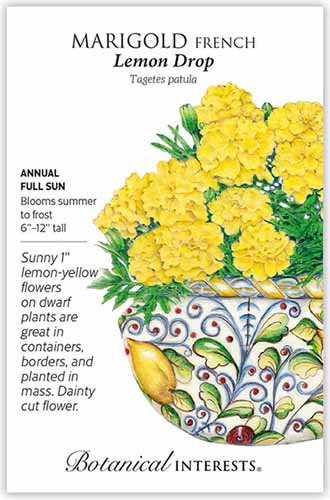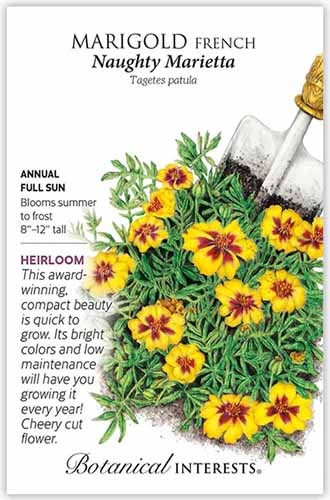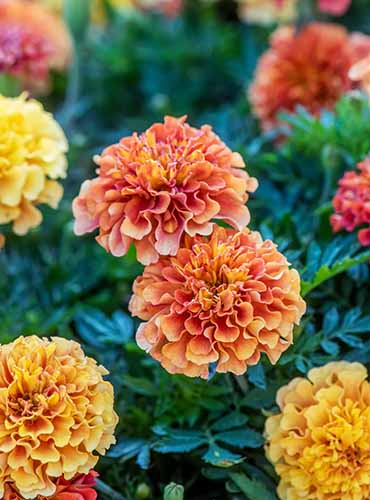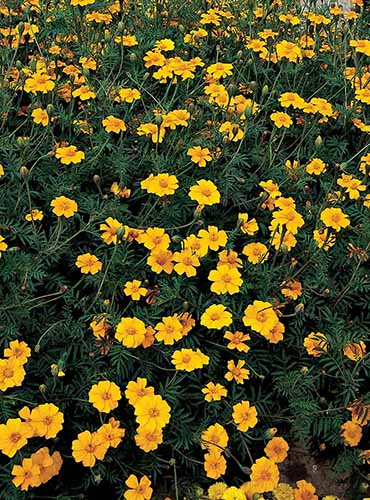How to Grow and Care for Marigold Flowers
Tagetes spp.
Before we get too far into this, we have a confession: We love marigolds, everything about them.
So, if you were expecting an article about these annual flowers that’s written with journalistic detachment, you’re out of luck.
This is our tribute to the peerless marigold, recognizing its great virtues and its hang ups as well, with unabashed affection.
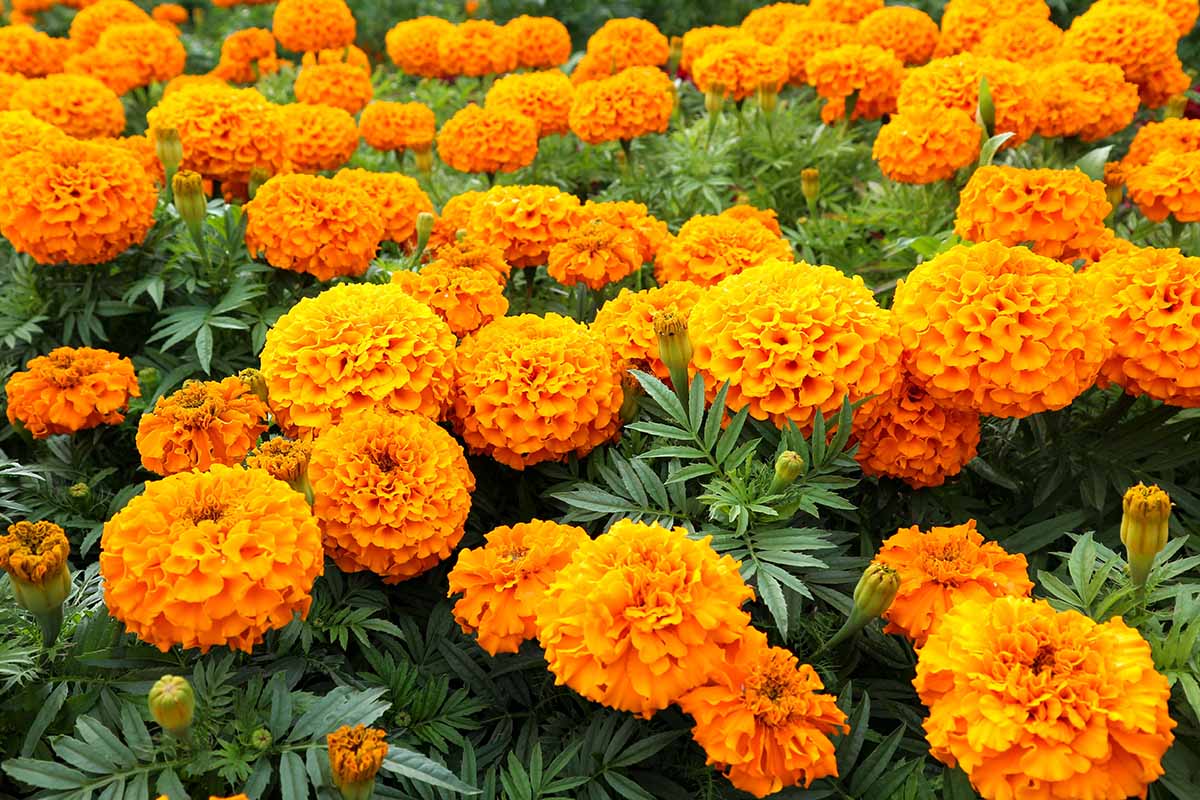

We link to vendors to help you find relevant products. If you buy from one of our links, we may earn a commission.
They might be a familiar sight, but marigolds have a few tricks available to them that can surprise even the most educated gardener.
Grab your coffee or your tea, because we’re headed to marigold town!
(That sounded a lot better in my head…)
Ready to let the love fest begin? Here’s what we’ll rave about in this guide:
Tagetes offer a slew of benefits for the rest of your garden.
From deterring pests to attracting pollinators and other desirable insects, and improving the soil quality, marigolds should find their way into your garden every year.
Cultivation and History
There’s an interesting apocryphal tale about the origin of this flower’s common name.
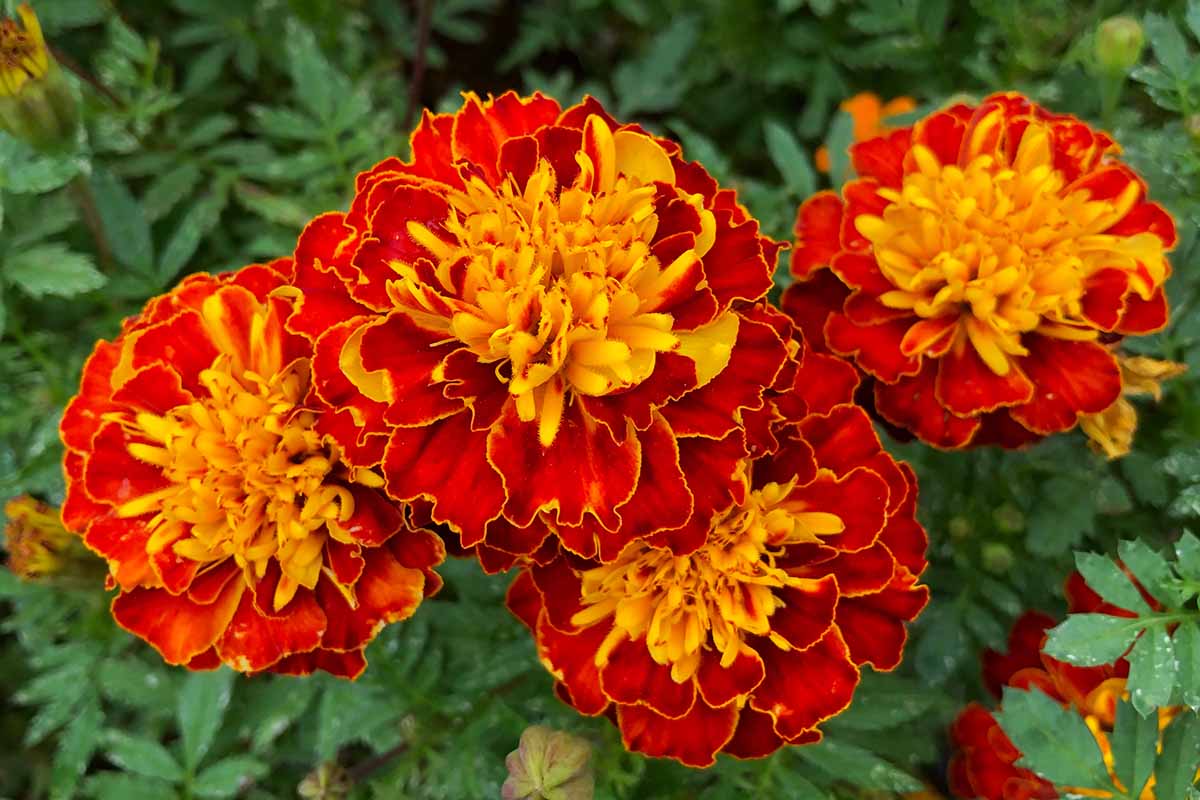

According to this tale, Mother Mary of the Christian tradition was robbed by bandits, but when they cut open her purse all that fell out were yellow flowers, something that would one day be named “marigold” (Mary’s gold) in her honor.
But there’s a little hole in that story – and not just the one in the purse.
The marigold species we’re discussing today are indigenous to the Americas. Discovered in the 1500s in Central and South America, these flowers had great religious and social importance to the native peoples of the Americas, and they eventually crossed the Atlantic to Europe.
Wherever the common name came from, the plants covered in this guide are botanically known as Tagetes.
T. erecta, commonly known as the African marigold, made its way to France and North Africa.
After a considerable length of time, the flowers naturalized to the environment of North Africa so that when European settlers visited the region, they assumed the flowers were African in origin.
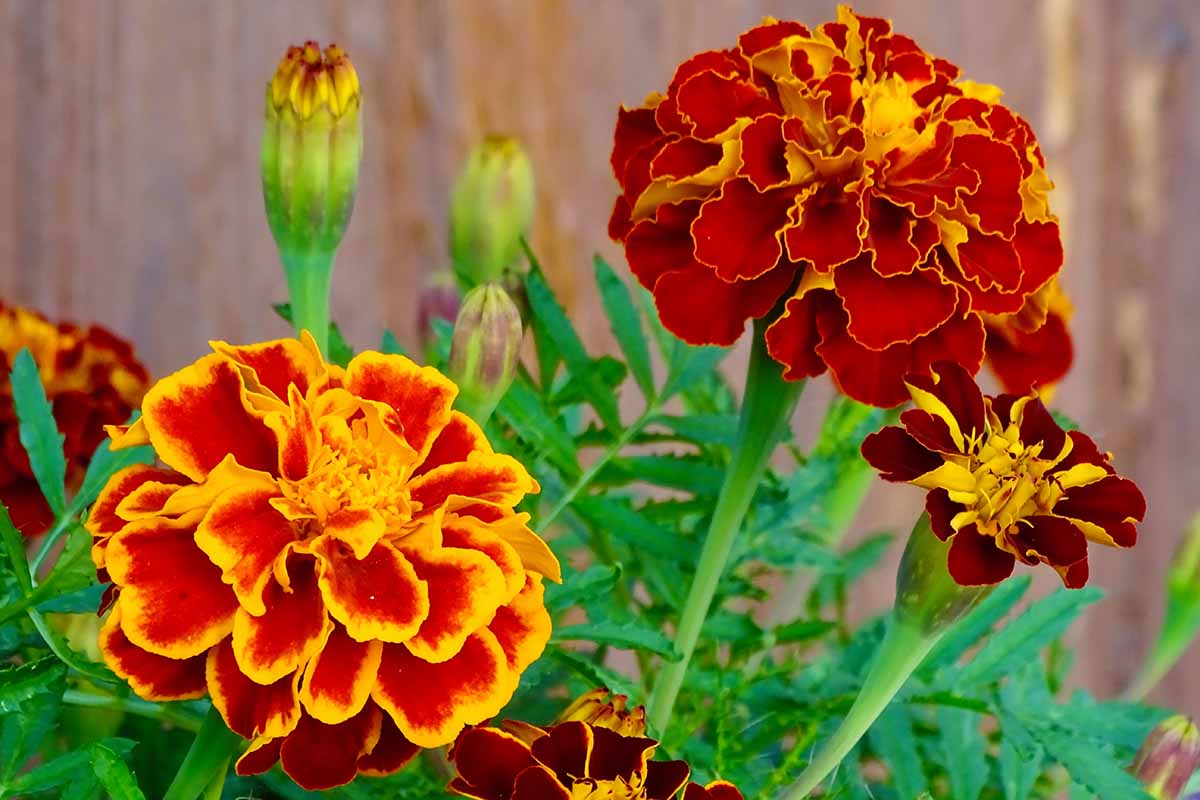

The French marigold, or T. patula, had a similar journey. Seeds crossed the ocean from the Americas with European explorers who were returning home.
T. patula made its home in France and became a popular flower in the region, earning its common name.
Both of these species then made another journey across the Atlantic and returned home to the Americas where they became a popular choice for North American gardeners.
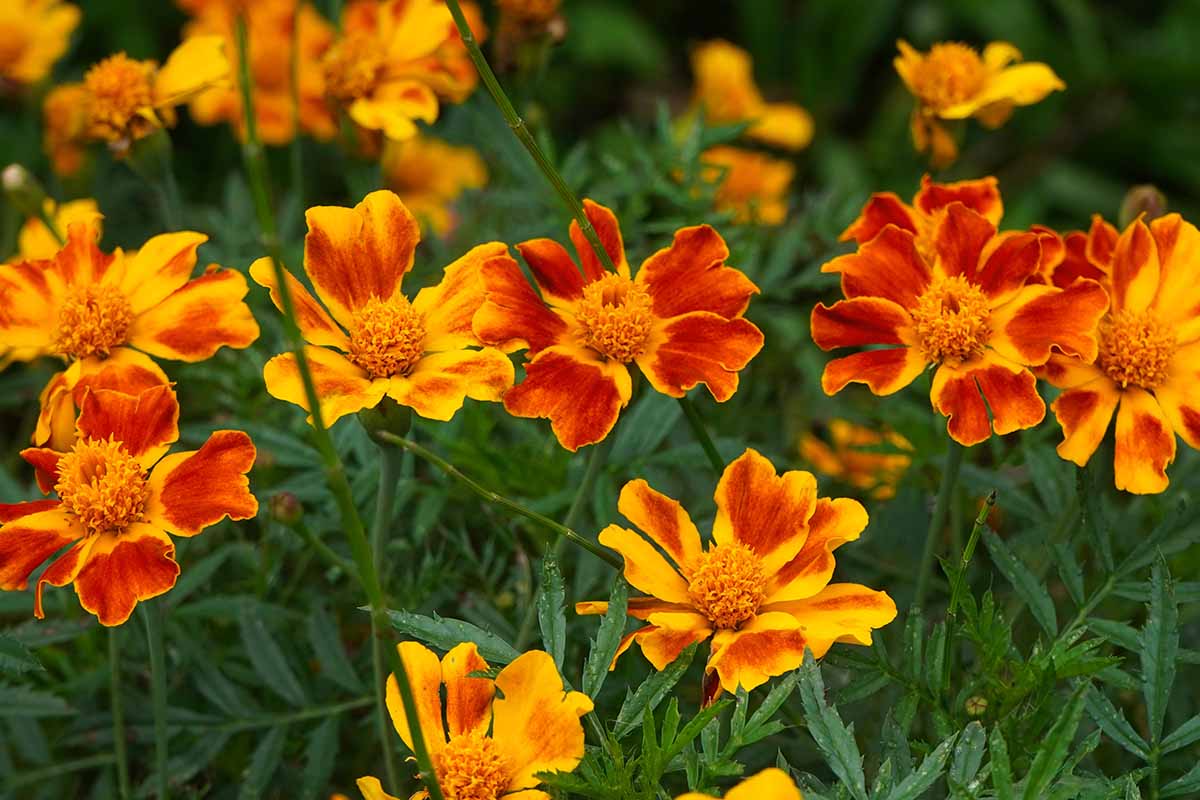

Signet, or golden marigolds (T. tenuifolia) stayed closer to home. This species hasn’t been quite as extensively cultivated, nor is it as popular as its cousins.
Marigold Propagation
Marigolds are so easy to grow from seed that if you simply leave them to their own devices, they’ll self-sow and readily produce volunteer seedlings without any intervention.


It’s nearly as easy to grow purchased seeds or starts. We’ll go over seed propagation first.
From Seed
If you’re a beginner or you want to be absolutely certain about how your plants and flowers will look, we recommend purchasing marigold seeds from a retailer, either online or in person, rather than collecting your own.
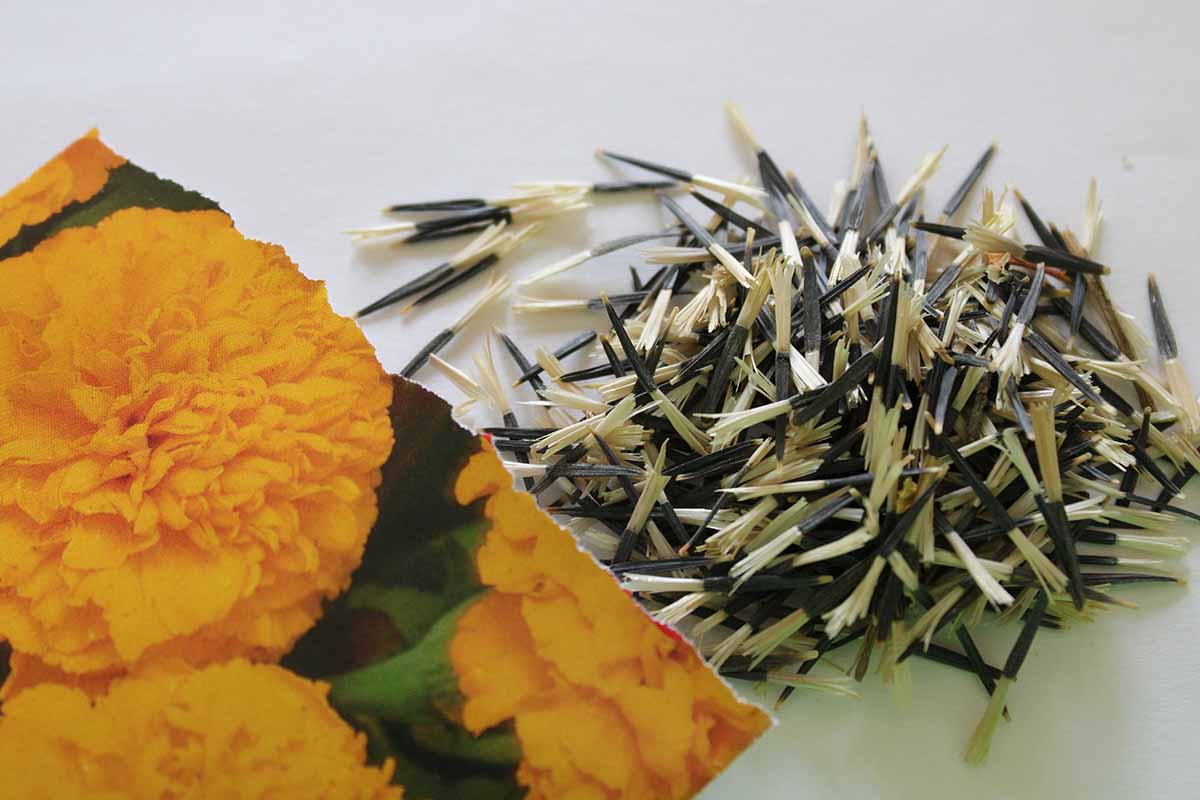

Many of the better-performing and prettier cultivars are hybrids, and they don’t grow true from collected seed.
On top of that, hybrid seedlings often crash shortly after germination, or they produce a stunted and weak version of the parent plant.
That being said, you can buy open pollinated heirloom varieties where seed collecting is a viable option. If you opt to grow some of these, visit our guide to collecting marigold seeds for planting for instructions.
If you want to have your marigold seedlings reach their prime size in time for mid-spring transplanting, start them indoors about 50 days before the last frost date, depending on the type you’re growing. The seed packet will tell you exactly how long you need.
Sow the seeds in seed-starting trays and cover them with a thin layer of seed-starting or potting mix.
We’re particularly fond of Tank’s Pro-Lite Seeding and Potting Mix for starting seeds.
Tank’s Pro-Lite Seeding and Potting Mix
It’s made of compost, coconut coir, and perlite. Grab yourself a 16-quart bag at Arbico Organics.
Marigold seeds do not need sunlight to germinate, but they do benefit from adding a clear plastic lid to the tray to help the soil retain moisture and heat.
Seedlings should germinate after a few days, at which point they should start receiving about six hours of light a day. Keep an eye on them and thin the seedlings once they have a second set of leaves.
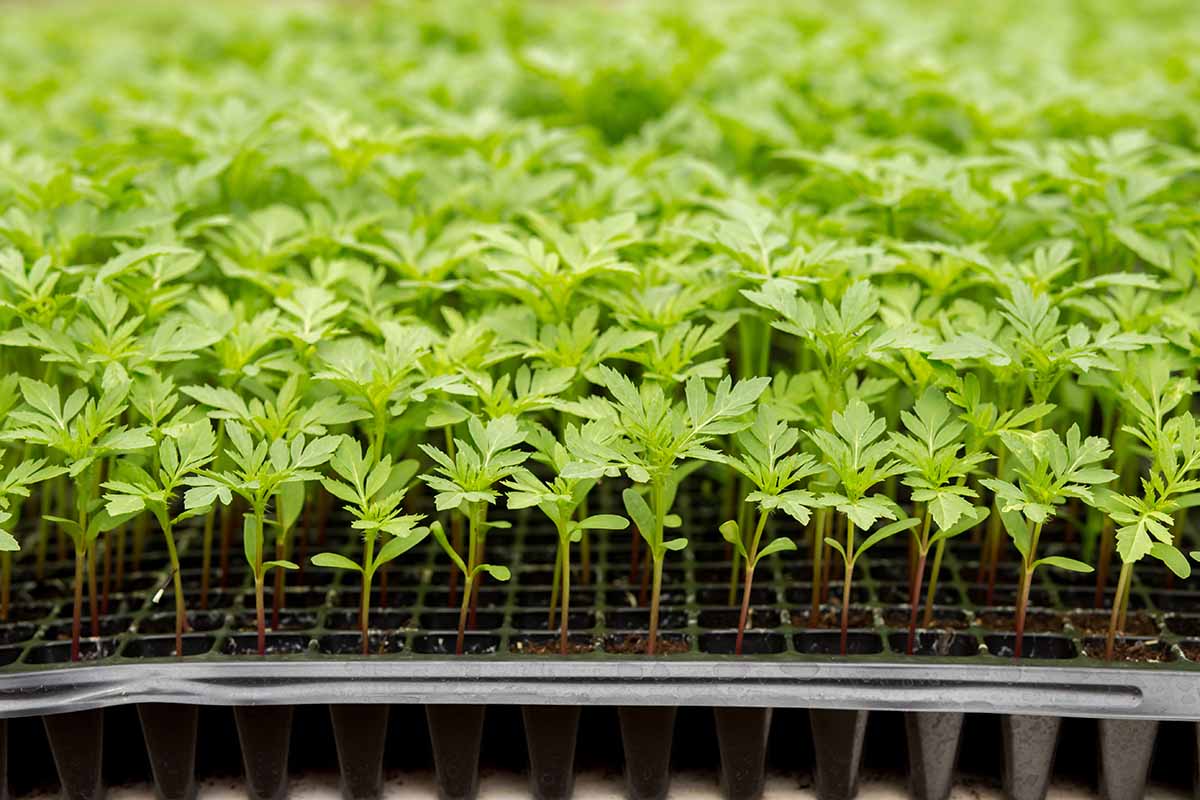

After you’ve thinned the marigold seedlings, you can transplant them into their own four-inch pots and keep them waiting inside until your last frost date. Keep the soil moist and make sure they’re getting at least six hours of sun.
If you’re sowing directly outdoors, bear in mind that you’ll need to keep any faster-growing weeds that could smother your babies out of the way.
Depending on the length of your growing season, your flowers may not reach their peak before the end of summer. That’s why many of us like to start them indoors.
Still have questions? Our guide to when and how to plant marigold seeds will shed even more light on the topic.
Transplanting
Whether it’s a six-pack of marigolds from the nursery or plants started at home in four-inch containers, you’ve got basically the same project on your hands.
Keep in mind that most marigolds sold in retail stores have been produced and grown under perfect conditions, and they likely have extensive root systems that are beginning to girdle the pot.
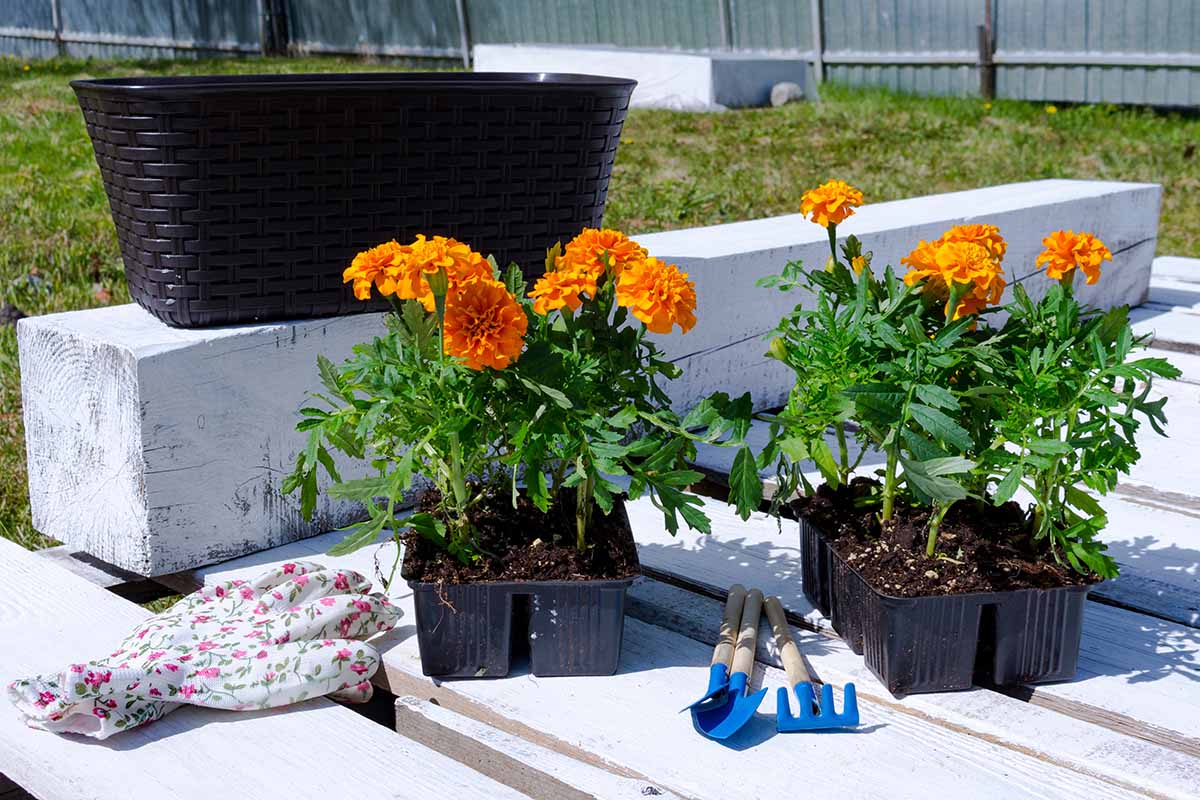

Girdling is bad news! This is when a plant’s roots grow horizontally in a circle, and can result in dead plants.
In both annual and perennial plants, girdled roots prevent the plant from ever grabbing a firm hold in the soil and taking up water and nutrients; they’re far more likely to die and “heave” out of the soil in this condition.
Tease apart those roots so they extend out and away from the center.
Yes, this is also stressful for the plant, but it will respond by establishing new roots and grabbing a firm foothold in its new home.
Watering becomes easier, and after a brief breaking-in period, you’ll find the plants happier and healthier.
Once the root ball is broken up a little bit, you can get to planting.
To avoid additional undue stress, it’s best to plant on an overcast day. But honestly, as long as you don’t leave the plants sitting in boiling sun for hours, marigolds don’t generally suffer from transplant shock.
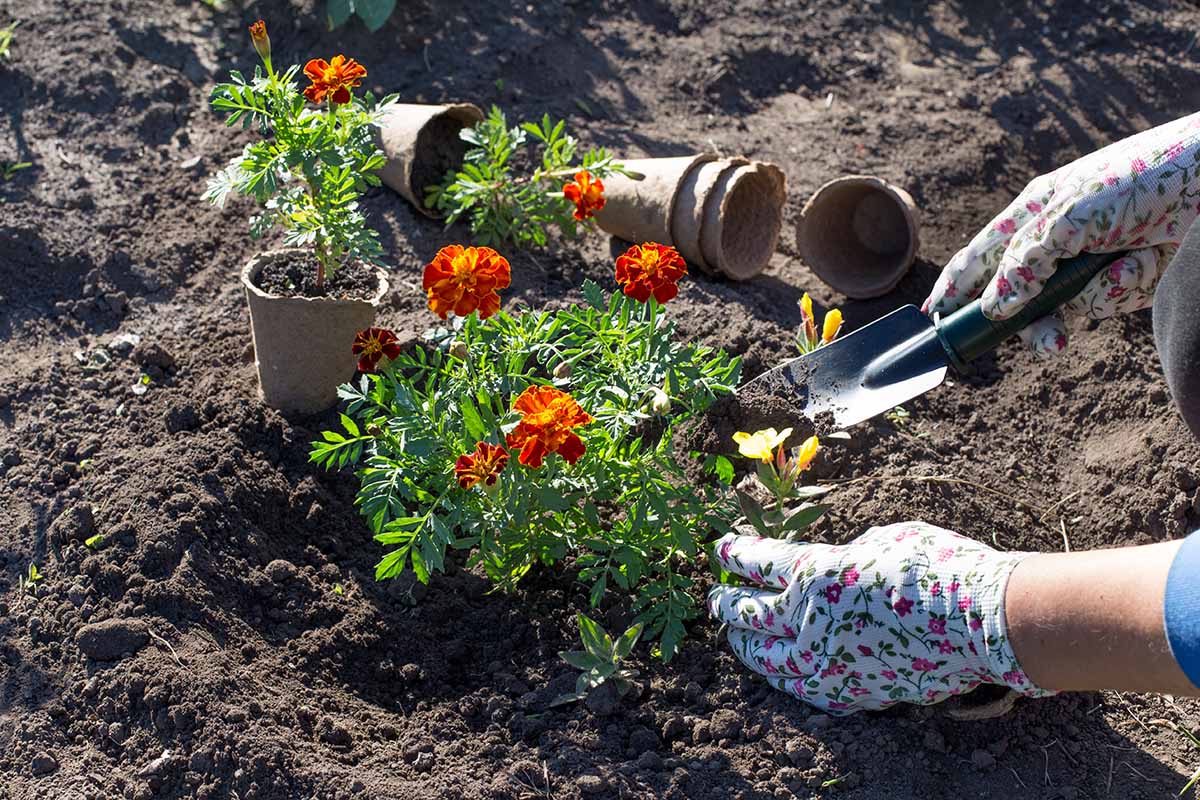

If your soil isn’t too dense, the planting hole only needs to be about 10 percent larger than the root ball, with just enough space to backfill some soil.
On the other hand, if your soil is dense and heavy (think clay), you’ll want to dig a hole that’s wider and deeper than the root ball by about 50 percent and work lots of well-rotted compost into the soil before you backfill.
When you’re finished planting, give your new transplants a nice drink of water, then check on them in the next day or two to see if they need more.
It only takes one to two weeks for the marigolds to start setting roots and becoming established, eliminating the need for watering except during droughts, depending on your climate.
How to Grow Marigolds
There’s a reason people have used these flowers as a garden staple for a long time. Tolerant of heat, drought, and pests, the marigold is about as easy to care for as they come.
You can plant them in almost any area that receives sufficient sun, six or more hours per day, and they are an ideal choice when you’re planting with purpose.
Marigolds are one of the best choices to use when you’re a free-spirited, hands off gardener who wants their plants to be happy.
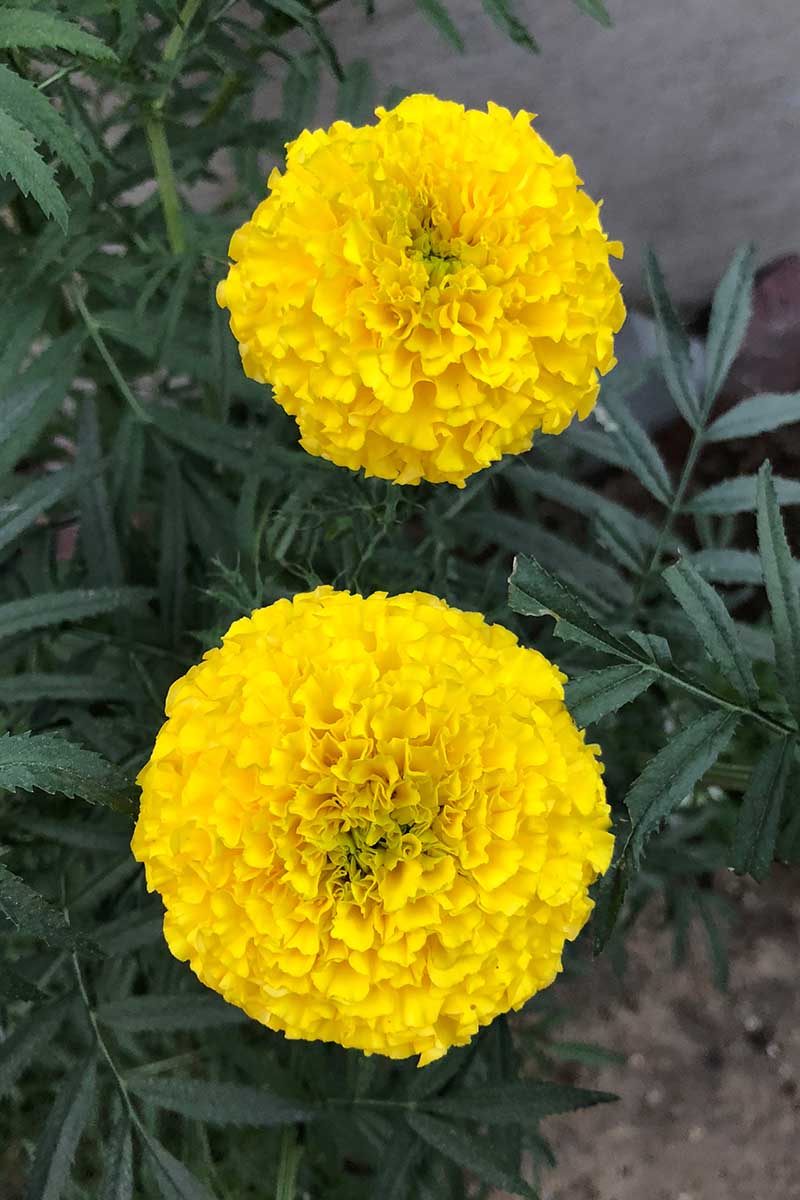

Similarly, they aren’t too fussy about soil. Slightly sandy, loamy, or clay is all fine. The soil should be slightly acidic to neutral with a pH of 6.0 to 7.0, though a bit out of this range is fine.
When first planting these guys, it’s best to soak the soil thoroughly. This is standard practice with most plantings. Not only does it give the plant a nice drink to get started growing in its new home, it also helps to settle the freshly disturbed soil.
Established plants don’t need much in the way of watering. In fact, unless the weather is unusually dry and hot, they don’t need anything besides a good soaking once a week. Rainfall is often enough for these tough flowers in all but the driest climes.
If you feel the soil and it’s dry all the way down as far as you can stick your finger, it’s time to add moisture.
Plants grown in containers are similarly tolerant of drought and only need to be watered when the top few inches of soil become dry to the touch. If the leaves start drooping, they’re in need of a drink sooner rather than later!
Be mindful not to water marigolds from the top. If their blooms get too wet, they will often turn into a mushy brown mess. Marigolds can be susceptible to root rot as well, if they are overwatered.
Native to sunny and warm climates, marigolds prefer brightly sunny areas with moderately rich soil.
They can withstand full sun exposure with impressive grace and only begin to show signs of stress when the weather is relentlessly hot, be it humid or dry.


This makes the marigold a perfect accompaniment to coreopsis, and a number of heat-loving herbs.
Although capable of growing in a part-sun environment, marigolds will never shine in these conditions.
In addition to developing weaker and less prolific blooms, when grown in the shade, they become susceptible to powdery mildew and a host of rots that affect buds and stems.
A light dressing of mulch will help the marigolds conserve water and makes for a neater planting area. You will only need a light application of mulch “for color” for this, not the inches of mulch used in vacant planting beds.
If you’d like to keep your flowers in containers, you couldn’t pick a better option than marigolds.
They do well in pots of all sizes. We have a guide that will explain the whole process and help you pick the right container.
Growing Tips
- Plant in full sun for the best performance.
- Grow in slightly acidic to neutral soil.
- Don’t overwater, only add water when the soil is dry and water at the soil level.
Maintenance
Maintaining marigolds is largely about deadheading. For continual blossoms, it helps to deadhead them, though it isn’t strictly required.
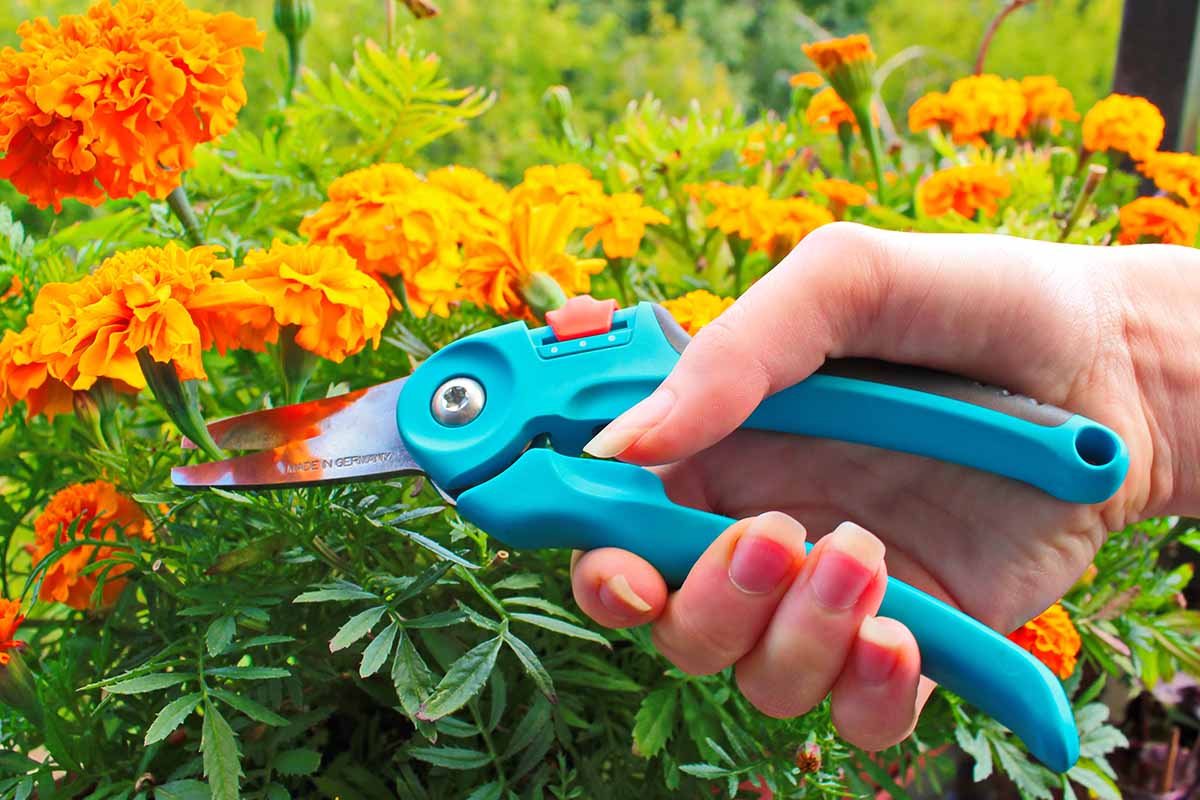

To be clear, you don’t have to deadhead. They’ll keep growing and blooming even without your help. But they will bloom more abundantly and won’t become leggy.
On the other hand, if you let the blossoms fade on their own and go to seed, you’ll probably have volunteer plants next year. And who doesn’t love a freebie? This can be done towards the end of the season.
You might need to stake extremely tall types, especially if they have large blossoms.
If you know you’re growing one that tends to droop or you’ve planted in a windy spot, place stakes or a cage in place before planting.
Marigold Species and Cultivars to Select
You literally can’t go wrong with any of the marigolds out there, depending on your needs. There are taller options, frillier options, and even those bred to keep pests out of the garden.
Let’s look at the stately African species first.
African
Reaching heights of up to four or five feet and topped with massive pom-pom flower heads, T. erecta can be a bit aggressive.
It wants to grow wildly and will knock over other plants to achieve this. T. erecta can be especially demanding of space in containers.
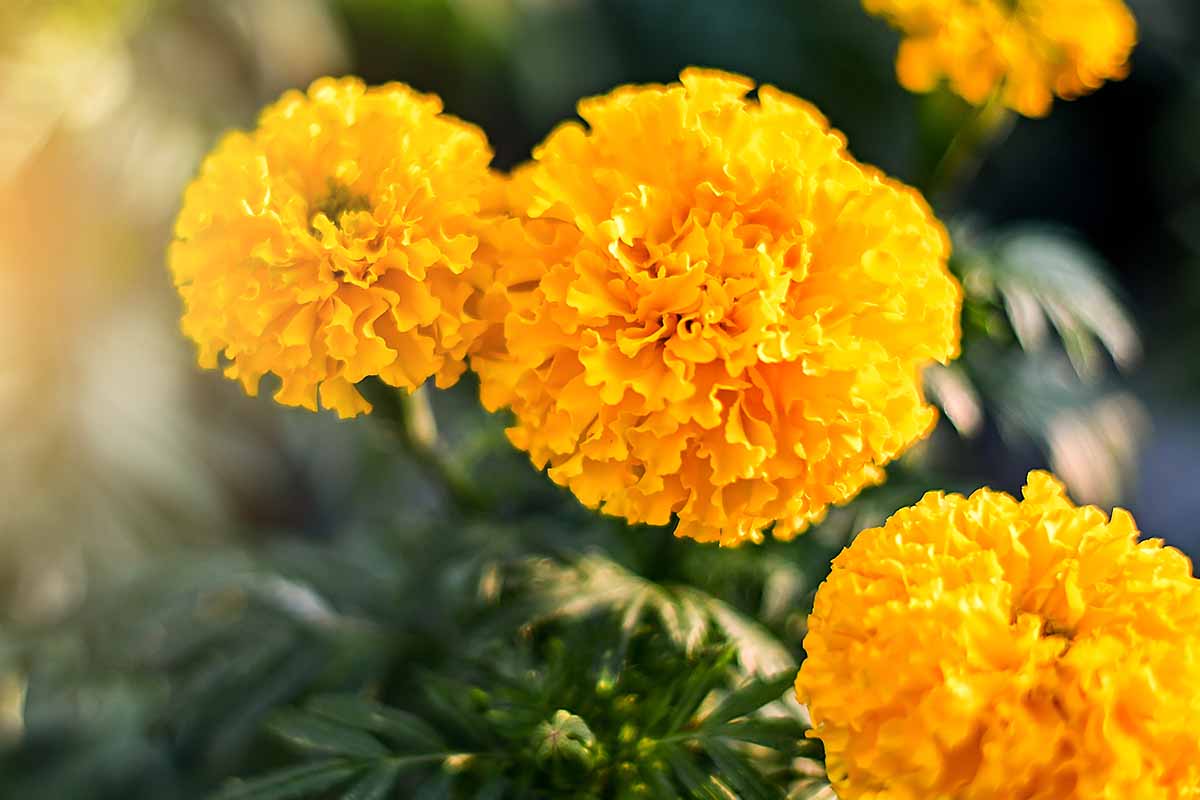

Still, it’s a favorite species if you choose the right spot.
The giant blooms are a sampling of delightful and cheery yellows and oranges that look like they’re straight from a big ol’ box of Crayola crayons.
They might require staking if they get too tall, but that’s alright. It’s worth the extra work.
There are an endless number of big, bold beauties to select from.
Crackerjack Blend is a mix of extremely tall varieties at over 30 inches, with massive, four-inch, double blossoms in orange-yellow to deep orange.
It’s like a never-ending firework display in the garden. You can purchase a 750 milligram packet of seeds from Botanical Interests.
’Hawaii’ has a deeply saturated color to its bloom that borders on the profuse.
This cultivar shines because it exhibits a rich orange color that nicely accents the other brighter shades of different cultivars. This type will grow to be about a foot high and wide.
As much as the primary colors appeal, a more restrained display can add elegance to the garden.
‘Kilimanjaro White’ hit the market in the late ‘70s after two decades of breeding and thousands of dollars spent.
Burpee Seed Company offered $10,000 to anyone who could breed a truly white cultivar.
Alice Vonk of Sully, Iowa managed to nail it in 1975. Since then, several more white cultivars have been bred, including this one, which was bred by Hem Zaden seed company.
The creamy-white blossoms are just under three inches wide with an open center that reveals the stamens. Bees love the access, and humans appreciate the added texture.
A marigold with such a storied history deserves a spot in every garden. Pick up a pack of seeds from Botanical Interests.
‘Pinwheel’ features boldly striped petals in burgundy and yellow on flowers up to four inches across, they are a delight.
From organic seed breeder and heirloom seed advocate Alan M. Kapuler who believed all plants should be part of the public domain rather than patented to restrict propagation, this is an heirloom cultivar that can be propagated and shared.
Visit High Mowing Seeds for seeds in various package sizes.
Curious to learn more about African marigolds? Check out our guide.
French
With a daintier and more compact flower, T. patula has the added benefit of possessing multicolored flower heads that its taller cousin cannot produce.
The French variety also tends to be a bit more tame with a shorter stature.
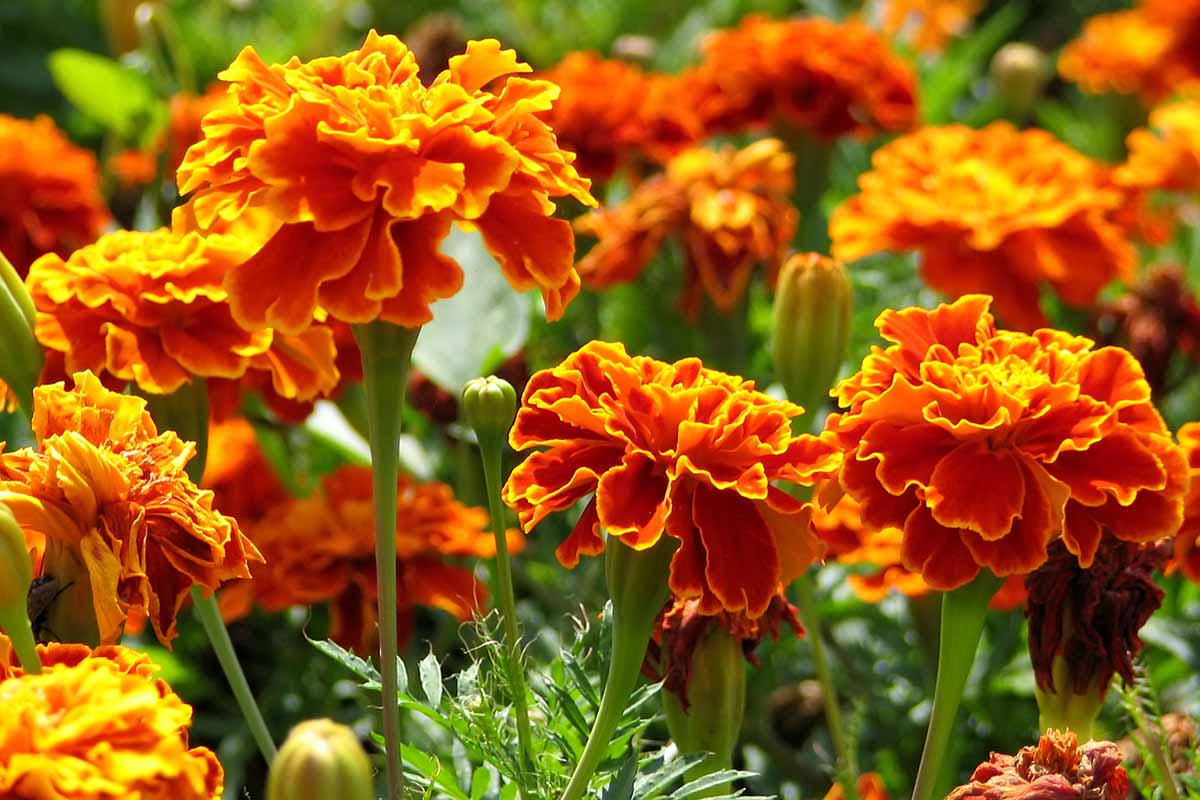

French types play well with vegetables, and offer a nice combination of color with tomatoes and cucumbers.
If purchased from a garden center, they tend to be sold in affordable eight-packs, giving you an excellent bang for your buck when buying live plants.
Favourite Blend hardly needs any further introduction. It’s a favorite for its yellow and red petals on single blossoms.
The foot-tall plants produce prolific blooms non-stop from spring through fall.
Botanical Interests has 500-milligram seed packets available.
Sometimes you just want an understated classic. ‘Lemon Drop’ has cheerful yellow flowers with cupped petals. It’s like a bowl full of sunshine if you plant it in a container.
Bring home a gram of seeds from Botanical Interests.
Classic film buffs will recognize the name ‘Naughty Marietta,’ named for a film starring Jeanette MacDonald.
On the original poster, the main character wears a frilly bold dress in red and yellow. The flowers on this plant look like the frilly costume, with a yellow base and maroon accents.
This compact, prolific French cultivar won an All-America Selections award in 1947 in the flower category. Head to Botanical Interests for a 500 milligram packet of seeds.
Marigolds come in a lot of colors, but rose gold wasn’t one of them – until ‘Strawberry Blonde’ came along. Each flower is covered in cupped rose, gold, and yellow blossoms.
They shift color over the season as the temperatures change, too. When it’s chilly, the flowers are more of a plummy orange-pink. In the heat, they’re gold, yellow, and pink.
Snag packages of 50 seeds or 12 live plants at Burpee.
Visit our guide for a comprehensive look at growing French marigolds.
Signet
T. tenuifolia is not commonly planted because it tends to grow obnoxiously. It will reach places you never intended and fight like a scrappy junkyard dog to hold onto its territory.
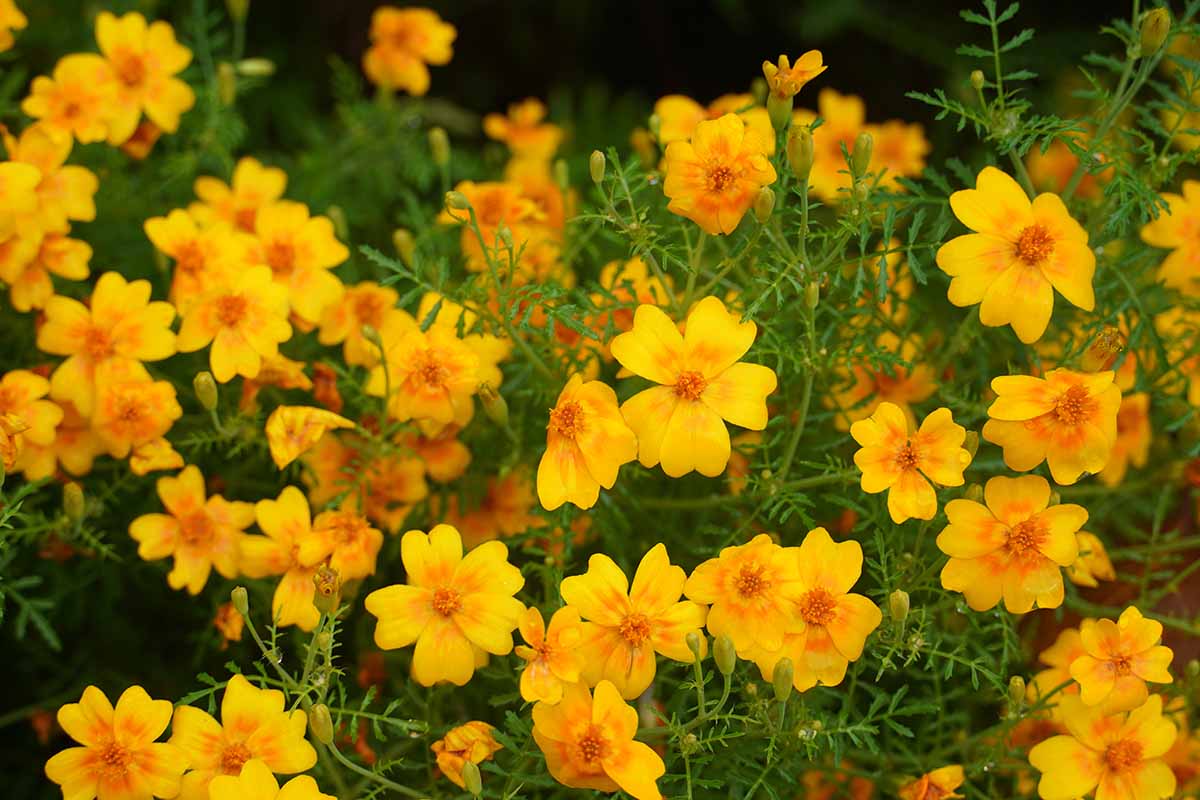

But it is perfect for those challenging dry spots. Signets work nicely in hell strips, slopes, rock gardens, or containers.
The Gem series offers mounded foot-tall plants with a relatively compact habit, lacy leaves, and bright yellow or golden blossoms, or a mix of both.
Visit True Leaf Market for lemon-colored, gold-colored, or a mix of colors in packs of 100, 500, 1,000, or 5,000 seeds.
Visit our guide to signet marigolds for more information.
Managing Pests and Disease
If we’re using the words “pests and disease” when talking about marigolds, it’s often because we’re referring to how good they are at deterring them!
These garden staples tough and rarely troubled by problems.
If you’d like to learn how to use marigolds to control pests, visit our article on the subject.
There are even marigolds you can buy that were bred specifically to control nematodes in the soil.
They’re called ‘Nema-Gone’ and you can pick up 2,000 seeds at Burpee.
That said, there are some pests that you might encounter.
Pests
Nematodes might not mess around with marigolds, but a few other invertebrates will. Pests not only stress the plants but they spread disease. Get rid of ‘em.
Aphids
Green peach (Myzus persicae) and melon aphids (Aphis gossypii) won’t hesitate to pull up to the marigold table with their napkins tucked in their shirts and a knife and fork at the ready.
Well, actually, they use their sucking mouthparts like straws to draw out the plant’s sap, but you get the general idea.
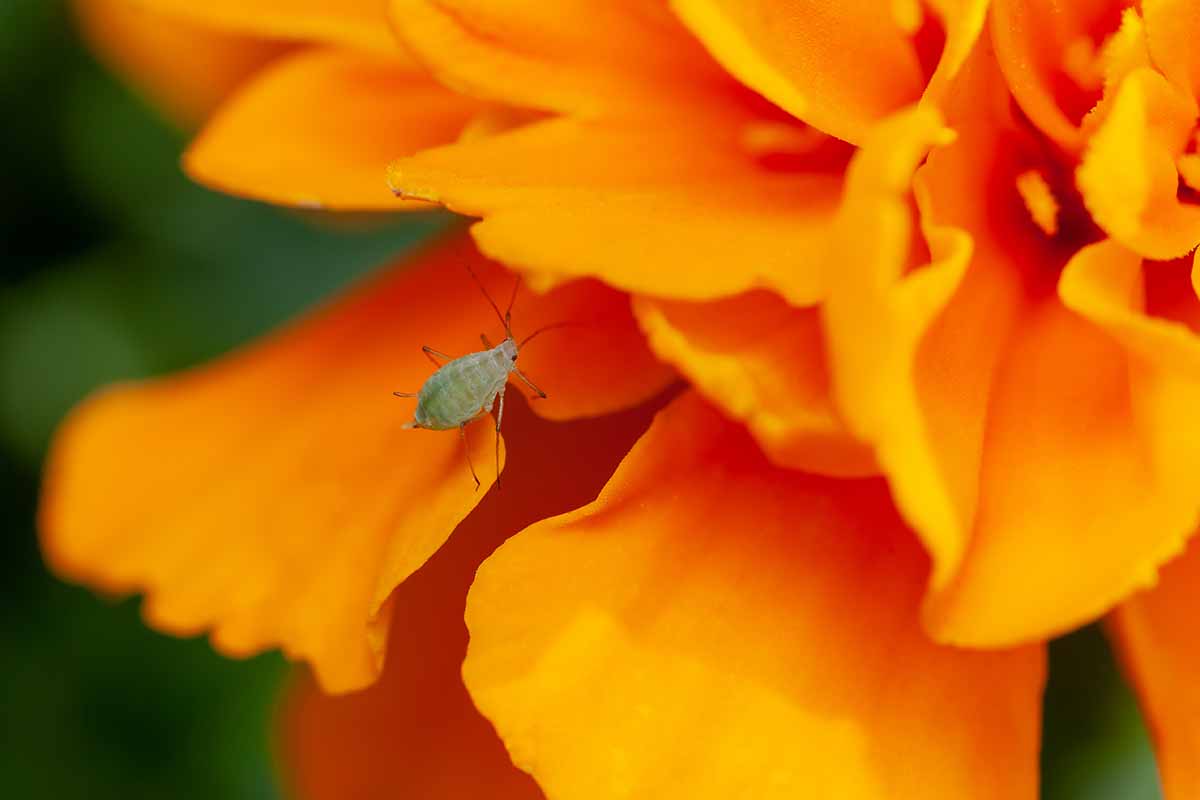

In large enough numbers, your poor plants will turn yellow, with stunted growth and smaller blossoms, plus fewer of them.
Because of the dense growth of these plants, it can be hard to spot the pests until the plants show symptoms.
Whenever you find aphids, get to work eliminating them. A strong stream of water will knock them off the plants.
If that doesn’t work, our guide to dealing with aphids in the garden has plenty more ideas.
Leaf Miners
Serpentine leaf miners, Liriomyza brassicae and L. trifolii, are small flies that lay eggs that hatch into annoying little maggots, and it’s these larvae that chew through the leaves of many plants, leaving telltale trails behind.
It’s hard to control these pests since the larvae hide in leaves, and any control has the potential to harm good bugs.
Instead, just pluck off any ugly leaves and let nature take its course. The damage is only cosmetic in most cases.
You can learn more about dealing with leaf miners in our guide.
Slugs and Snails
I can’t tell you how many times I’ve gone outside to find jagged leaves, missing flowers, and slimy trails all over my young marigolds.
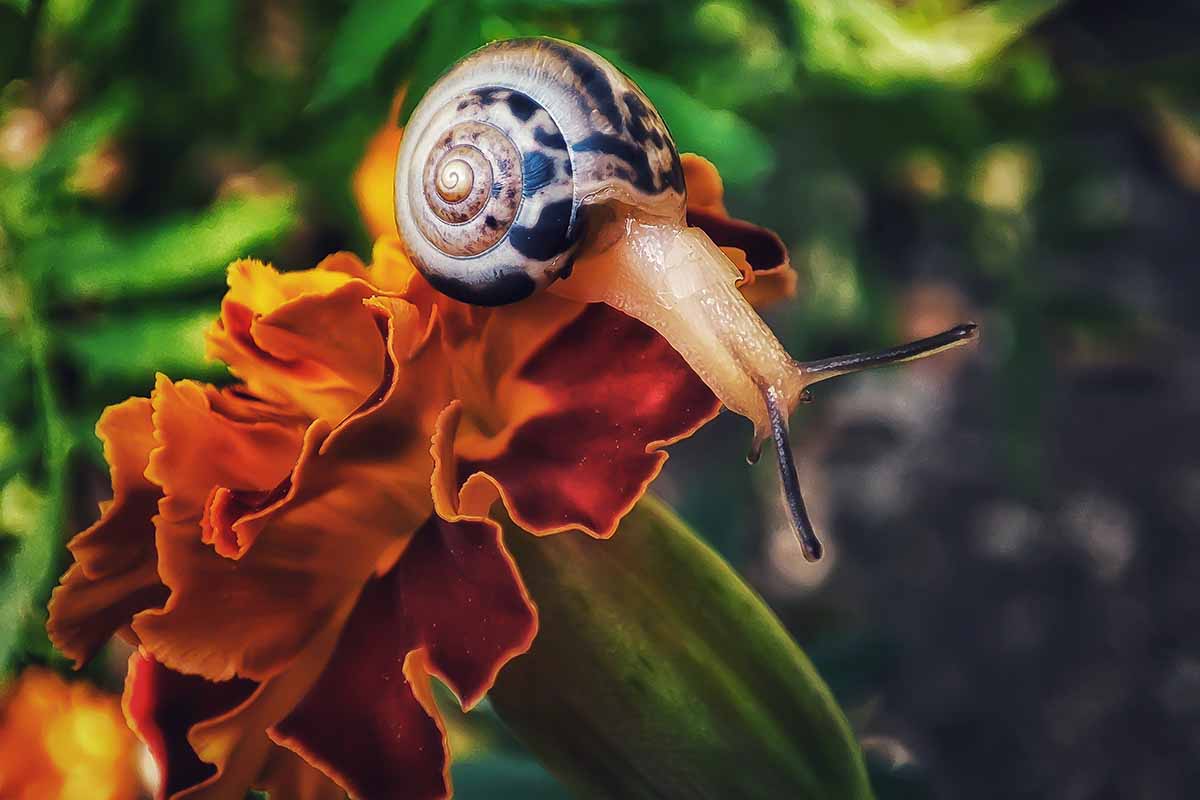

But once the plants are mature, they weather the onslaught with little trouble. It’s just a matter of protecting those little ones out in the garden.
I use slug bait, but you do you. Our guide to managing slugs and snails offers plenty of alternatives.
Spider Mites
Spider mites are common on all kinds of garden plants and houseplants. They’re itty-bitty relatives of ticks and spiders that use their sucking mouthparts to feed on the sap of plants.
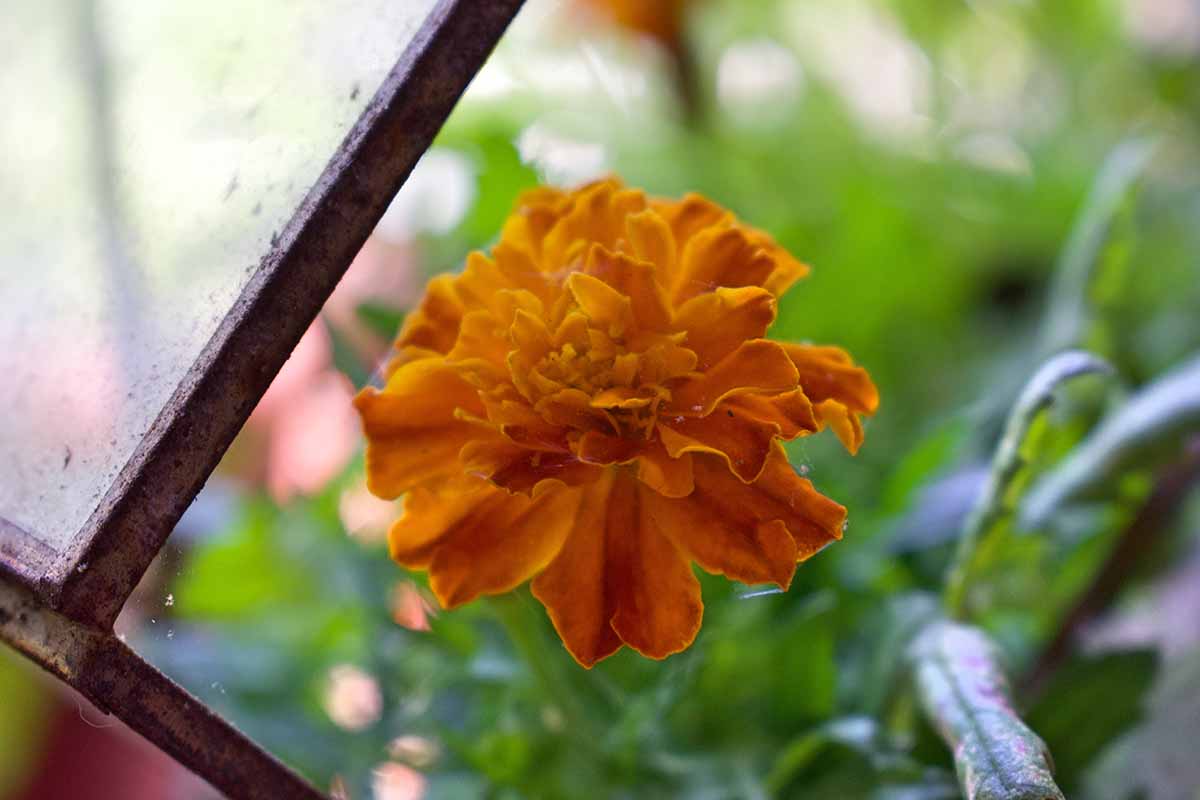

When they feed on marigolds, the leaves will develop yellow spotting, but since this symptom can look like other things, you’ll need to really get in close to examine your plants.
Look for fine webbing, since the bugs themselves are difficult to see. The webbing is often cluttered with what looks like flecks of dirt, which are the exoskeletons discarded during molting.
Addressing a spider mite infestation isn’t too difficult and can often be done by gently spraying the plants down once or twice a week.
For more tips and specific information, please visit our guide to spider mites.
Disease
Don’t you hate it when someone tells you how impervious a certain plant is to disease when you’re dealing with a problem at that very moment?


No living thing is immune to disease. But marigolds truly are tough little bloomers.
Unless they’re stressed, even when an infectious pathogen does come to visit, it usually won’t cause too much of a problem.
You mainly want to watch for root rot, which is caused by overwatering, and aster yellows, which is spread by pests.
There are just a few other pathogens worth knowing about, even if they are relatively rare. Visit our guide to learn more about marigold diseases.
Best Uses for Marigolds
It’s difficult to find a place where marigolds are unwelcome – except perhaps for the aggressive signet types!
In pots and borders, as a specimen, in cottage gardens and in vegetable beds, marigolds are the bee’s knees.
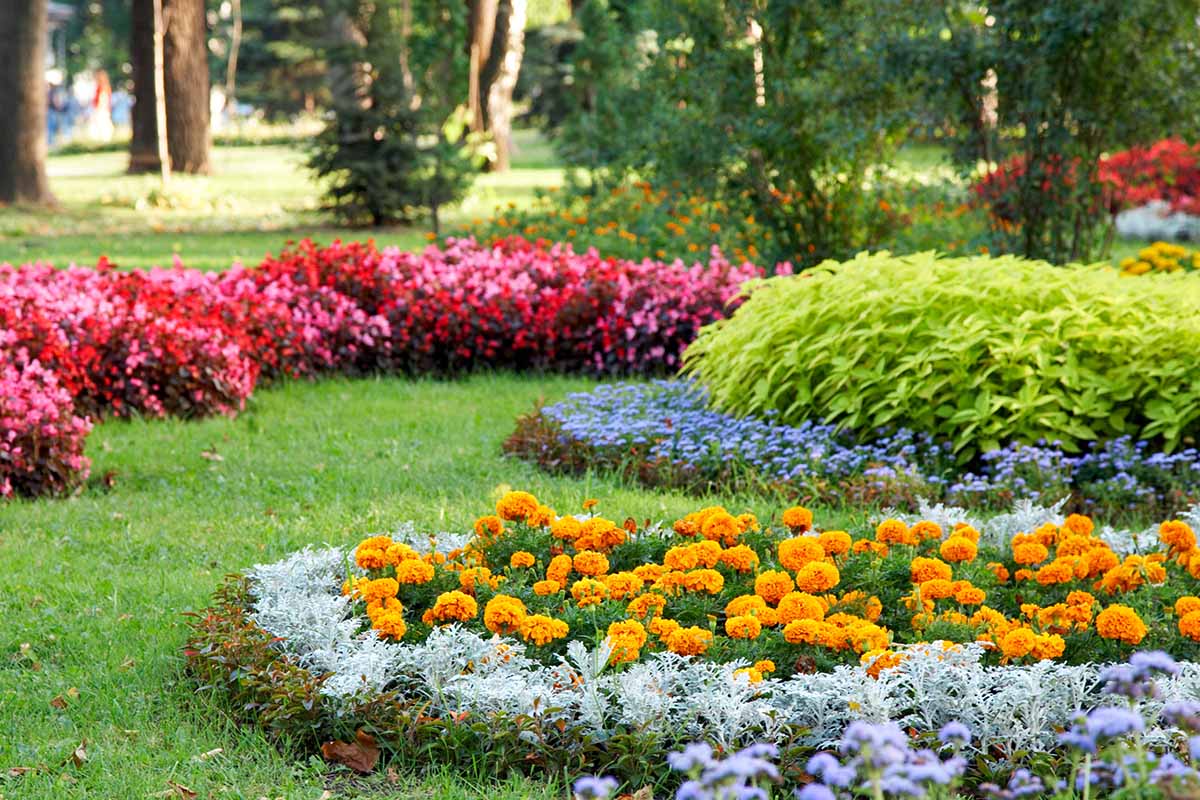

The aboveground plant has been proven to deter pests that would otherwise be ready to start munching on other tasty and prized plants that are growing in the garden.
Additionally, the roots have been shown to deter nematodes for up to a year from when the plant fades in the fall.
I’ve seen other gardeners plant them when rotating their crops, to keep nematodes at bay.
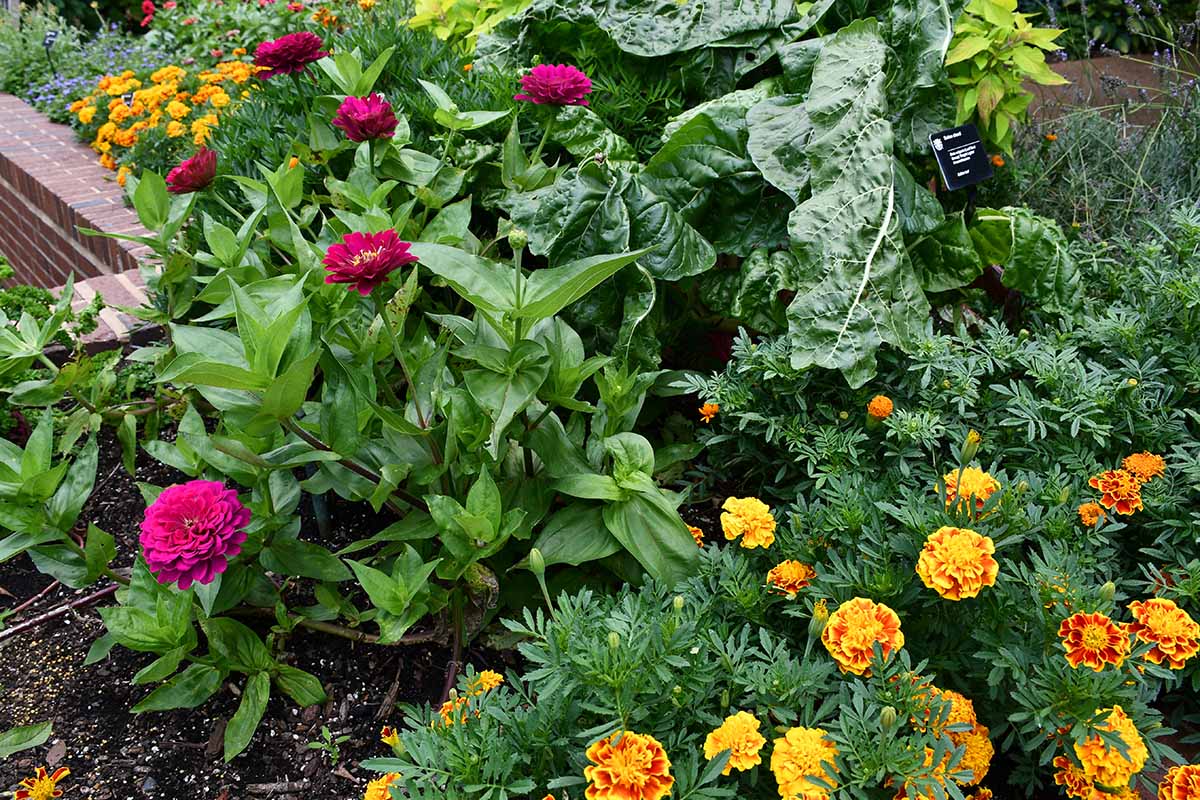

Ideal as a companion plant, marigold is often planted as a border or buffer around a garden, since the pungent scent is so offensive to certain pests. From yours truly over here, I think marigolds smell like summer, but to each their own.
I’ve specifically planted marigolds with petunias, alyssum, dahlias, roses, and another favorite, chamomile.
Tomatoes get along especially well with them. Try combining marigolds, tomatoes, basil, and alyssum in a planting. It looks nice and the plants seem to enjoy teaming up together. There’s enough variety in these choices to make some pretty stunning combinations.
Quick Reference Growing Guide
| Plant Type: | Flowering annual | Flower Color: | Burgundy, gold, orange, pink, red, white, yellow/green |
| Native to: | Central and South America | Maintenance: | Low |
| Hardiness (USDA Zone): | 1-11 | Tolerance: | Drought, pests |
| Bloom Time: | Spring, summer, fall | Soil Type: | Moderately fertile |
| Exposure: | Full sun | Soil pH: | 6.0-7.0 |
| Time to Maturity: | 55-100 days, depending on cultivar | Soil Drainage: | Well-draining |
| Spacing: | 1 inch (seed), 6-12 inches (plants) | Attracts: | Beneficial predators, pollinators |
| Planting Depth: | 1/4 inch (seed), depth of root ball (transplants) | Companion Planting: | Alyssum, basil, chamomile, dahlia, petunia, rose, tomato |
| Height: | Up to 24 inches, depending on variety | Uses: | Borders, companion plantings, containers, specimen |
| Spread: | Up to 24 inches, depending on variety | Order: | Asterales |
| Growth Rate: | Fast | Family: | Asteraceae |
| Water Needs: | Low to moderate | Genus: | Tagetes |
| Common Pests and Diseases: | Aphids, leaf miners, slugs, snails, spider mites; aster yellows, root rot | Species: | Erecta, patula, tenuifolia |
Marvelous Marigolds Are a Garden Delight
They’re everywhere and are among the most recognizable flowers in the garden, but marigolds didn’t have to cheat to earn this reputation.
They’re vigorous growers that require little care, putting on a great show of color through the entire summer. Plus, they’re a breeze to start from seed and can even deter some pests.
Told ya we were biased.
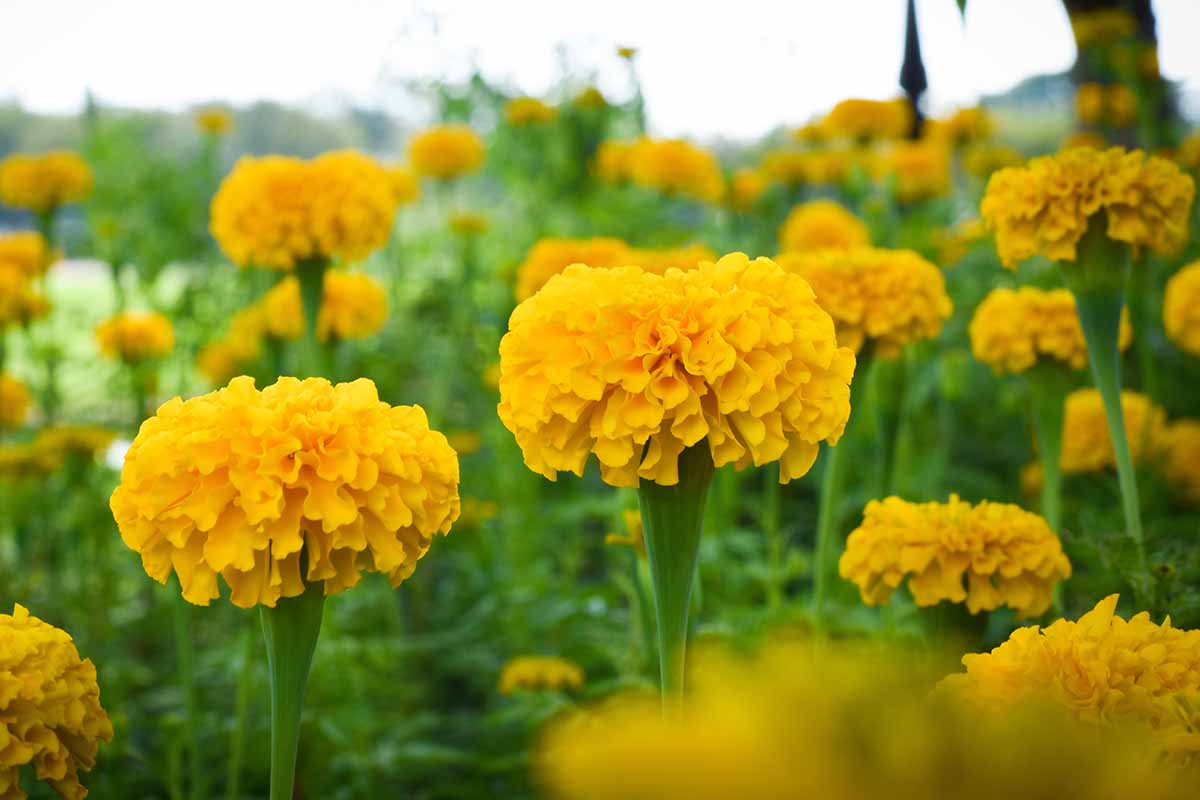

Which kind of marigolds are your favorite? Are you planning on a pot full of Frenchies? Or are you using a bunch of African types to create a garden backdrop? Let us know your plans in the comments, and feel free to ask any questions!
You just know we have lots more to talk about when it comes to marvelous marigolds. Dig further into the Tagetes genus with these articles:

